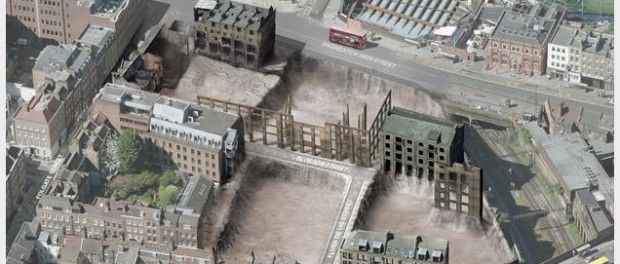Dan Cruickshank blasts developer on AHMM scheme

Dan Cruickshank launched a blistering attack on British Land and Historic England over plans to demolish a large part of historic Norton Folgate in London’s East End.
He denounced the “powerful” developer for caring only about profits and likened the struggle to fighting the Nazis.
The veteran campaigner said he was prepared to squat the threatened properties, as he did in the 1970s when the Spitalfields Trust was formed during a previous fight in the same streets with British Land.
Cruickshank accused Historic England, formerly English Heritage, of being “on the wrong side of the barricades”.
He was “completely baffled” by the organisation’s decision to support the scheme, designed by an AHMM-led team featuring Duggan Morris, DSDHA and Stanton Williams.
“English Heritage’s position is shocking,” he told a packed public meeting in St Leonard’s Church, Shoreditch, on Wednesday night.
“Their position is also shocking on the lovely 18th- and 19th-century buildings on the Strand next to Somerset House. It’s not an isolated case. They are rather strange at the moment.
“They should be our allies but have been either useless or on the wrong side of the barricade. It’s heartbreaking.”
Searching for an explanation, he suggested: “They are subject to political control. The money comes from the government and the government is pro-development.”
A man in the audience claiming to work for Historic England but speaking in a personal capacity said: “Our position on Smithfield was baffling. Our position on loads of things is baffling.
“There are people at English Heritage who give a shit about these things. We do a lot of good work but it’s like the NHS – people only hear about the mistakes and not the everyday successes. There’s a lot of buildings standing in this country [thanks to Historic England].”
Cruickshank described British Land’s plans for Norton Folgate as “a step too far” and asked how much could be lost before a place ceased to exist.
The developer wants to demolish 70% of the buildings on its site, in the Elder Street conservation area, he said.
“How dare these people feel they can just obliterate this ancient part of London with a corporate open-plan space for profit,” he said.
“They don’t care about it; they care about their own bank balances. They are powerful people, British Land. So were the Nazis. You have to take these people on.”
Occupation might be the trust’s next move, he said. “I think it’s a very good tactic. What else do you do in the end? If you care about something, direct action is where you have to go next. I am looking forward to a few nights in those lovely buildings in Blossom Street.”
Alec Forshaw, a retired planning officer who represented the Victorian Society at the Smithfield inquiry, said he was confident they had a good chance of winning if the planning application – currently with Tower Hamlets council – went to public inquiry.
British Land’s head of development Nigel Webb has previously said it had consulted far and wide about its plans, including speaking to English Heritage and Cabe, and had come up with a sensitive scheme.
He added that it had brought in Duggan Morris, DSDHA and Stanton Williams “to ensure design variation, in keeping with the character of the wider area”.
He said: “We have developed these plans following extensive constructive engagement. This is a heritage-led scheme in a conservation area which will not only integrate with and enhance its surroundings, but provide a bridge between the City of London and Shoreditch. The telecoms, media and technology sector is one of the engines of London’s growth and one of our principal ambitions here is to create an environment in which these occupiers can thrive and grow.”
A Historic England spokesperson said: “Historic England champions historic places and helps manage change in and around them. This is what we do every day in our detailed, constructive discussions with local authorities, developers, interest groups and members of the public and what we did with the examples raised in Mr Cruickshank’s speech.
“In the case of Norton Folgate we have advised that the proposals are well-designed and sensitive to the heritage in question. We recognise that the King’s College proposal to demolish the unlisted buildings at 152-153 Strand will harm the conservation area. The local authority must weigh this up against the public benefit that should result from enabling the University to improve its teaching facilities and therefore enhance its international reputation.
“We are asked to advise on difficult decisions about England’s heritage every day but our guiding principle is that we are for the historic environment and always work in its best interests.”
